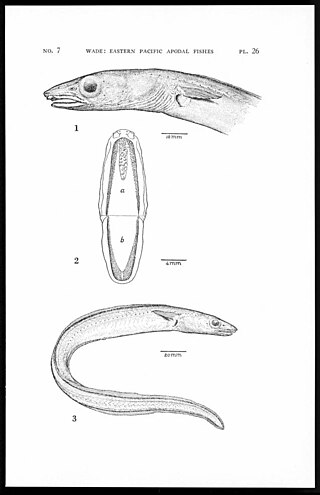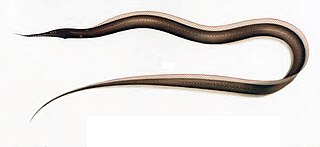
Chlopsis is a genus of eels of the family Chlopsidae.
The stripesnout false moray is an eel in the family Chlopsidae. It was described by William Beebe and John Tee-Van in 1938, originally under the genus Arenichthys. It is a tropical, marine eel which is known from the eastern Pacific Ocean. It generally dwells at a depth around 82 m.
The bicolor false moray is an eel in the family Chlopsidae. It was described by George S. Myers and Charles Barkley Wade in 1941, originally under the genus Garmanichthys. It is a tropical, marine eel which is known from around the Galapagos Islands in the southeastern Pacific Ocean. Males are known to reach a maximum total length of 20 cm.
The mottled false moray, is an eel in the family Chlopsidae. It was described by Alvin Seale in 1917, originally under the genus Garmanichthys. It is a tropical, marine eel which is known from the west coast of Africa, as well as regions in the eastern and western Atlantic, western Pacific, and western Indian Oceans. It typically dwells at a depth of 64–355 m. Males can reach a maximum total length of 19.9 cm.
Chlopsis slusserorum is an eel in the family Chlopsidae. It was described by Kenneth A. Tighe and John E. McCosker in 2003. It is a marine, deep-water eel which is known from Fiji and the Solomon Islands, in the western central Pacific Ocean. It typically dwells at a depth of 366–487 m. Males can reach a maximum total length of 14.1 cm.
The shortsnout conger, also known as the thicklip conger, is an eel in the family Congridae. It was described by Samuel Garman in 1899, originally under the genus Atopichthys. It is a tropical, marine eel which is known from the eastern central Pacific Ocean, including Colombia, Costa Rica, Ecuador, El Salvador, Guatemala, Honduras, Mexico, Nicaragua, and Panama. It leads a reclusive, benthic, burrowing lifestyle, and typically dwells at a depth range of 27–2198 metres. Males can reach a maximum total length of 30 centimetres.
Paraconger ophichthys is an eel in the family Congridae. It was described by Samuel Garman in 1899, originally under the genus Atopichthys. It is a tropical, marine eel which is known from Cocos Island, in the eastern central Pacific Ocean. It is known to dwell at a depth of 1953 metres.
The largehead conger is an eel in the family Congridae. It was described by Samuel Garman in 1899, originally under the genus Uroconger. It is a marine, deep water-dwelling eel which is known from southern Canada to Chile, in the eastern Pacific Ocean. It dwells at a depth range of 165–935 metres. Males can reach a maximum total length of 100 centimetres.
The neighbor conger is an eel in the family Congridae. It was described by Samuel Garman in 1899, originally under the genus Uroconger. It is a marine, deep water-dwelling eel that is known from the southwestern and western central Atlantic Ocean, including the Bahamas, Brazil, Cuba, and Mexico. It dwells at a depth range of 101–503 metres. Males can reach a maximum total length of 46.2 centimetres.

Gnathophis cinctus, the hardtail conger or Catalina conger, is an eel in the family Congridae. It was described by Samuel Garman in 1899, originally under the genus Atopichthys. It is a tropical, marine eel which is known from the eastern central and southeastern Pacific Ocean, including Chile, Colombia, Costa Rica, Ecuador, El Salvador, Guatemala, Honduras, Mexico, Nicaragua, Panama, Peru, and the United States. It dwells at a depth range of 9–336 metres, and leads a benthic lifestyle, burrowing into loose sand. Males can reach a maximum total length of 42 cm.
Facciolella gilbertii, known commonly as the Dogface witch-eel, is an eel in the family Nettastomatidae. It was described by Samuel Garman in 1899. It is a marine, deep water-dwelling eel which is known from the eastern central Pacific Ocean, including California, USA, and Panama. It is known to dwell at a depth of 935 metres. It is often caught in bottom trawls. Females are oviparous, and the larvae are planktonic. Males can reach a maximum total length of 61 centimetres.
Hoplunnis sicarius is an eel in the family Nettastomatidae. It was described by Samuel Garman in 1899, originally under the genus Atopichthys. It is a marine, tropical eel which is known from the eastern central Pacific Ocean, including Mazatlan, Mexico, and Panama. It is known to dwell at a depth of 1,431 metres (4,695 ft), and inhabits substrates. Unlike many eel species, it does not form burrows.
Venefica ocella is an eel in the family Nettastomatidae. It was described by Samuel Garman in 1899. It is a marine, deep water-dwelling eel which is known from the eastern Pacific Ocean. It is known to dwell at a depth of 1,953 metres (6,407 ft).

Venefica tentaculata is an eel in the family Nettastomatidae. It was described by Samuel Garman in 1899. It is a marine, subtropical eel which is known from the eastern central and northwestern Pacific Ocean, including Mexico, Nicaragua, Japan, and the United States. It dwells at a depth range of 100 to 500 metres, but may dive even deeper. Males can reach a maximum total length of 90.0 centimetres (35.4 in).
The death-banded snake-eel is an eel in the family Ophichthidae. It was described by Samuel Garman in 1899. It is a tropical, marine eel which is known from the eastern central and southeastern Pacific Ocean, including the central Gulf of California, Colombia, Costa Rica, Mexico and Panama. It dwells at a depth range of 35–760 metres, and forms burrows in sandy and muddy bottoms. Males can reach a maximum total length of 86 centimetres.
The wrinkled snake-eel is an eel in the family Ophichthidae. It was described by David Starr Jordan and Charles Harvey Bollman in 1890. It is a marine, tropical eel which is known from the eastern central and southeastern Pacific Ocean, including the Galapagos Islands and the Cocos Islands. It is also speculated to occur in Malpelo Island. It is known to dwell at a depth of 200 metres (660 ft), and inhabits sediments of sand and rubble. Males can reach a maximum total length of 68 centimetres (27 in).

The Galapagos snake eel is an eel in the family Ophichthidae. It was described by David Starr Jordan and Charles Harvey Bollman in 1890. It is a marine, tropical eel which is known from the eastern central and southeastern Pacific Ocean, including Colombia, the Gulf of California, Costa Rica, and the Galapagos Islands in Ecuador. It dwells at a depth range of 3 to 30 metres, and inhabits reefs, preferring to live in areas bearing a mixture of boulders, gravel and sand. Males can reach a maximum total length of 71 centimetres (28 in).
Avocettina bowersii is an eel in the family Nemichthyidae. It was described by Samuel Garman in 1899. It is a marine, deep water-dwelling eel which is known from California, U.S.A.; Peru, and Chile. It dwells at a depth range of 92–641 metres, although the type specimen was collected from a depth of 2,692 metres.
Serrivomer sector, known commonly as the sawtooth eel, the saw-tooth snipe or the deep-sea eel, is an eel in the family Serrivomeridae. It was described by Samuel Garman in 1899. It is a marine, deep water-dwelling eel which is known from the eastern and western Pacific Ocean, including Japan, Chile, and California, USA. It dwells at a depth range of 0 to 3,243 metres, most often around 305 metres (1,001 ft). Males can reach a maximum total length of 76 centimetres (30 in).
Agassiz' smooth-head is a species of fish in the family Alepocephalidae. It is named for the scientist and engineer Alexander Agassiz (1835–1910), who commanded the 1899 survey aboard the USS Albatross on which the fish was discovered.



